
This article was updated on February 22nd, 2024

You probably don’t pay a lot of attention to your dog’s poop, until the day you notice some blood in it. In this article, our veterinarians Dr. Chyrle Bonk & Dr. Jamie Whittenburg the top reasons & how to help your dog.
WARNING: A little farther down, we’re going to share some graphic pictures of dog poop with blood. Your dog’s health is worth taking seriously, and it might help you understand what is going on with your dog.
Select the picture that fits your situation the best (or keep reading)



Top causes of blood in a dog’s poop
1. Inflammation of the digestive tract
Inflammation anywhere along the digestive tract (Also known as hemorrhagic gastroenteritis) can lead to bloody poop. Dogs will often show other signs, such as not eating, vomiting, abdominal pain, and a fever.
Inflammation can be caused by a variety of causes, for example spoiled food, or viral or bacterial infections.
Prognosis: Mild cases may resolve with home care (for example a bland diet), but more serious cases will require veterinary intervention.
2. Eating something they shouldn’t have
Your vet may refer to this as “garbage gut,” as some dogs will get bloody stools after getting into the trash or eating something they shouldn’t have. This can be garbage, as well as bones or sticks, toys, or too many table scraps. Dogs may also show signs of not eating, vomiting, diarrhea, and abdominal pain.
“If this is the first time you’ve seen blood in your dog’s poop, it was just a small amount, and they aren’t showing any other signs, you may choose to watch them for a day or two and carefully check all of their bowel movements. They may have eaten something that could discolor his poop or have mild irritation from a diet change.”
3. Internal parasites
Having a heavy worm load can cause blood in the stools. This is because adult worms, of various species, attach to the linings of the intestines. A lot of these worms can cause bleeding of the lining, which goes out with a bowel movement. Dogs may also be losing weight, have a dull, scruffy coat, or you may see worms or eggs in their feces.
4. Cancer
Tumors in the digestive tract may bleed, which will lead to bloody feces. Dogs may also lose weight and have difficulty pooping depending on where the tumor is.
5. Other diseases
Blood in a dog’s poop is most often an issue of the digestive tract, but there are a few conditions outside of the gastrointestinal system (digestive system) that may cause a dog to bleed. Liver and kidney disease, immune dysfunction, and blood clotting issues may also be to blame. Exposure to some toxins can also cause bloody stools as well.
Signs that you should see your veterinarian
- There is blood with several bowel movements,
- A lot of blood with one bowel movement, or
- Your dog is showing other signs that something is wrong (not eating, vomiting or diarrhea that lasts longer than 48 hours, abdominal pain, or dehydration)
- Your dog seems distressed or not comfortable.
Blood in dog’s poop can vary in appearance
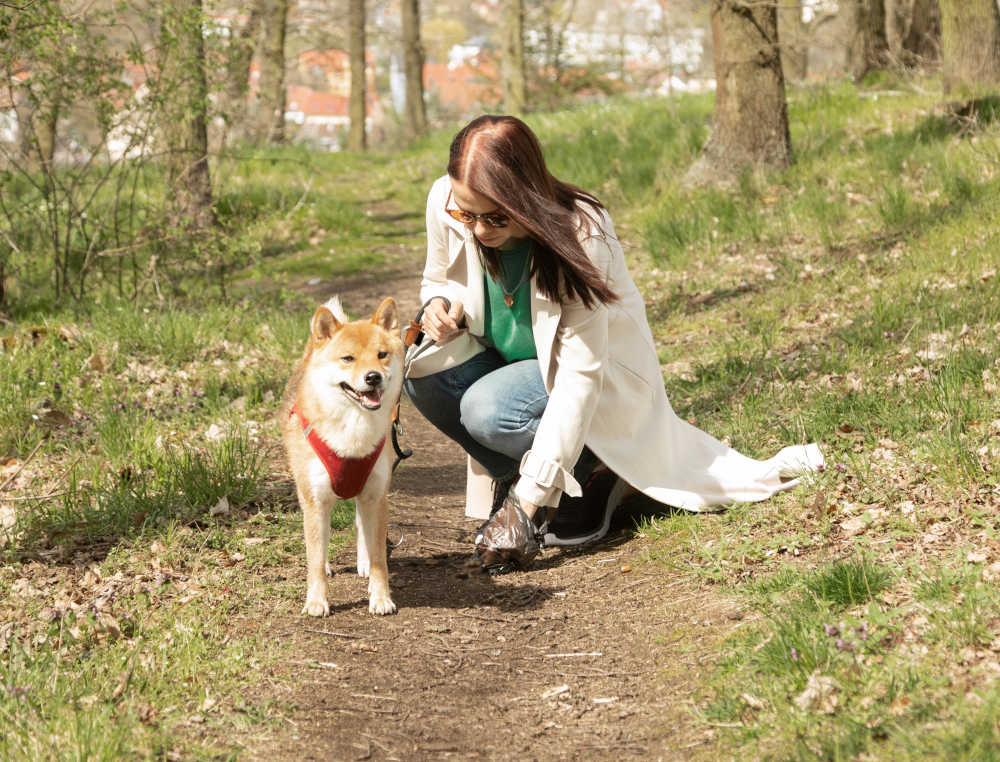
Here’s where those pictures of blood in dog poop we warned you about come into play.
“You may be surprised to know that blood in dog poop doesn’t always look the same. In fact, it can look quite different depending on what the cause is.”
1. Picture of Bright Red Blood (Hematochezia) in Dog Poop:
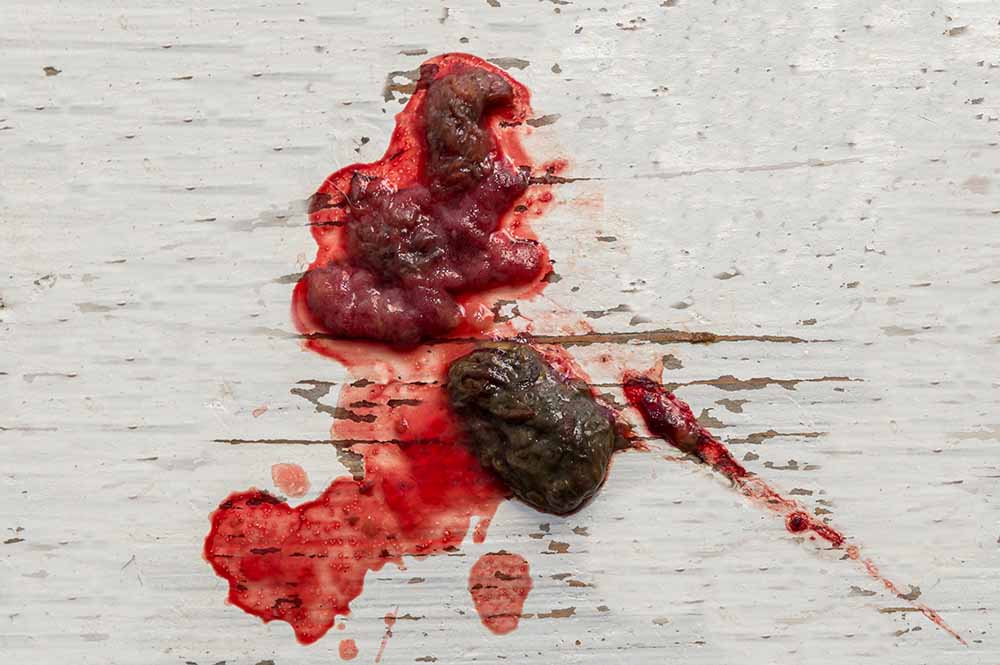
If the blood in a dog’s poop is bright red, it indicates a lower digestive system issue. That’s because the blood that goes through the upper part of the digestive system gets broken down, to a point, and turns dark red, brown, or even black. Bright red blood is often seen with diarrhea and dogs may also poop large volumes more frequently.
Bright red blood in dog poop may be due to hemorrhoids or other colonic irritation or colitis. Take note of any other signs that your dog may be showing.
“Some cases of hematochezia will be one-time only occurrences and nothing to worry about. However, if your dog is also having diarrhea, not eating, or straining to poop, see your veterinarian.”
Veterinary treatment for hematochezia can range from $200 to $1000 for a mild to moderate infection or more to treat a serious infection or tumor. Treatment may require fluids, anti-nausea medications, antibiotics, hospitalization, and a special diet.
2. Picture Showing Bright Red Bloody Streaks in Dog Poop:
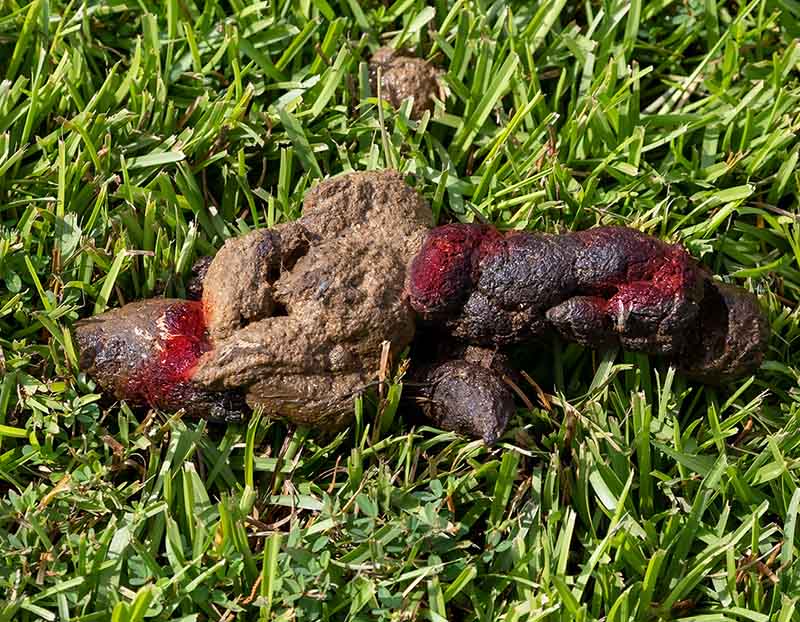
Again, bright red blood indicates an issue in the colon. Tinges of blood may be caused by mild irritation, tumors, or anal gland issues. Your dog may also strain to defecate.
If you notice bloody streaks in your dog’s poop once or twice and he isn’t showing any other signs, it’s more than likely nothing to worry about. If it becomes an all-the-time thing or they aren’t eating, are vomiting, or are doing anything else abnormal, see your veterinarian.
Mild irritation to the colon or rectum will typically go away on its own. Giving them a soft, bland diet for a day or two may help. Veterinary treatment may include expressing the anal glands or something more serious such as tumor removal. Costs can range from $50-$1,000 or more depending on the cause.
3. Picture Showing Raspberry Jam Blood in a Dog’s Poop:
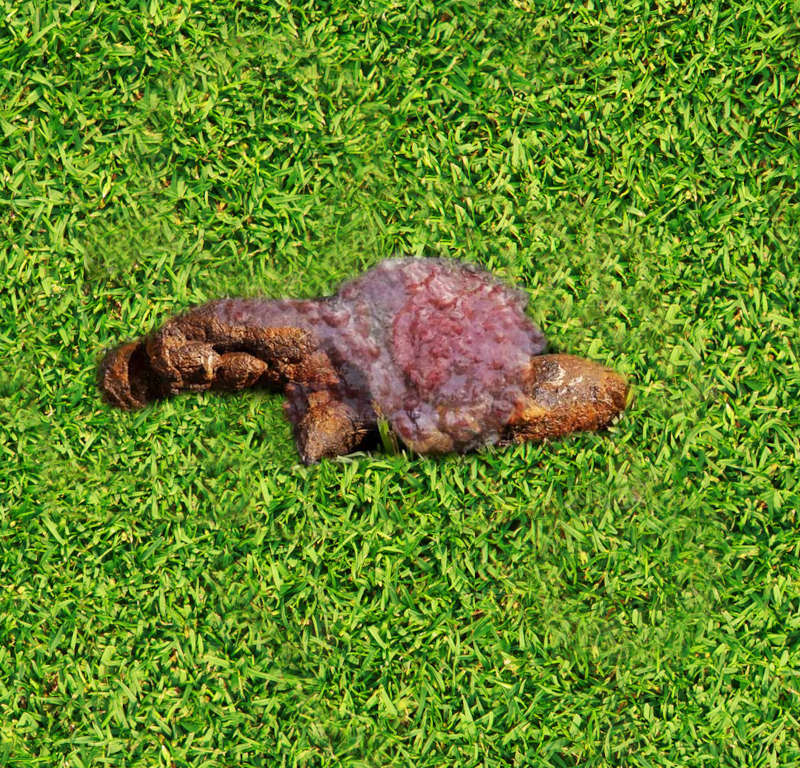
Sorry for the food reference, but mucousy blood in dog poop may look like raspberry jam or jelly. Lots of mucus mixed with blood may indicate inflammation of the digestive tract (hemorrhagic gastroenteritis). Dogs may also have abdominal pain, vomiting, and possibly a fever. If your dog is showing any of these signs, see your veterinarian.
Treatment for “raspberry jam” / “jelly” blood in the feces may require hospitalization, fluids, anti-nausea medications, and antibiotics. Costs can range from $200 to over $1,000. You can also read our article about: Home Remedies to Help A Dog With Poop That Looks Like Jelly With Blood.
4. Picture Showing Black, Tarry Dog Poop (Melena)
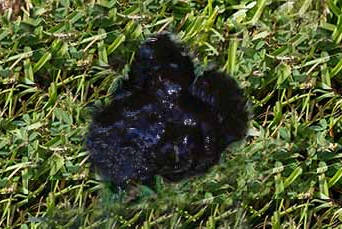
Dark brown or black blood can sometimes be pretty hard to spot but can indicate some serious conditions. Melena is the presence of blood in a dog’s poop that has gone through the digestive tract. Instead of being bright red like fresh blood, this blood is broken down as it moves through the digestive system. Black, tarry poop is typically more solid and may indicate stomach ulcers, inflammation in the stomach or small intestine, or cancer in the upper digestive system. Dogs may have varying signs, including vomiting, not eating, abdominal pain, and weight loss. Learn more with our article about black dog poop.
Most cases of melena are going to require veterinary attention. Diagnostics and treatment are going to depend on what other signs are present and the cause. It’s not uncommon to pay $800-$1,000 to diagnose and treat infections or $2,000 or more for cancer.
5. Pure Blood
Pooping what seems like pure blood usually indicates inflammation or infection of the digestive tract. The lack of feces with the blood just means that your dog hasn’t been eating, and therefore, not making any feces.
“Always see your veterinarian if your dog is pooping pure blood as well as showing any other signs of not eating, vomiting, or abdominal pain.”
The cost to treat will range from $200 to over $1,000.
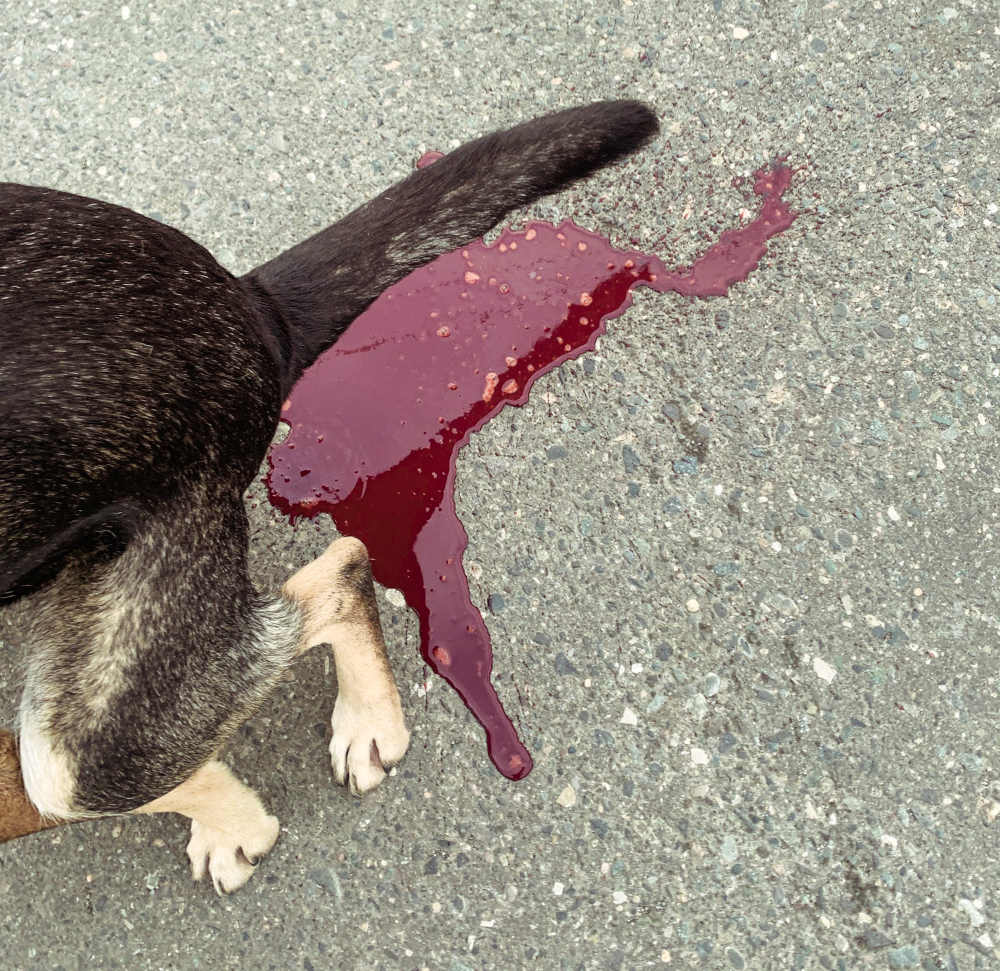
Blood in dog poop along with vomiting, diarrhea, and not eating require veterinary intervention
A normal bowel movement with a little streak of blood every once in a while is usually nothing to think twice about. However, if there is blood with every bowel movement, a lot of blood with one, or if your dog is showing any other signs that something is wrong, see your vet as soon as possible.
Not eating, vomiting or diarrhea that lasts longer than 48 hours, abdominal pain, or dehydration all warrant an immediate veterinary visit. Also, if your dog seems distressed, contact your vet as soon as possible.
Some causes of bloody poop can be fatal
Pooping blood can be an indication of something very serious going on with your dog. The loss of blood in poop is usually too small to actually cause death, but the cause behind the bloody poop can be fatal. Severe hemorrhagic gastroenteritis can cause death due to dehydration or septicemia-a whole body infection.
Of course, uncontrolled bleeding from the rectum can lead to death if it’s severe enough. While this is uncommon, it can happen if there is a severe injury to the lower colon, rectum, or anus.
Related Post: Red or Inflamed Anus: Here is What to Do
What to do if your dog is pooping blood
If this is the first time you’ve seen blood in your dog’s poop, it was just a small amount, and they aren’t showing any other signs, you may choose to watch them for a day or two and carefully check all of their bowel movements. They may have eaten something that could discolor his poop or have mild irritation from a diet change.
If you notice any worms or eggs in the feces, tell your veterinarian so that you can get your pet treated.
Signs that your dog needs to their veterinarian
- Severe bleeding or continuous blood
- Lethargy: this can be indicator that the blood loss is having a negative effect on your dog’s body
- Loss of appetite and/or vomiting
- Blood in stools that persists for more than 24 hours
- Higher frequency of bloody bowel movements
- Diarrhea associated with blood in the stool
- Constipation
- Your dog’s condition worsens or your dog is showing other signs of illness
“If your dog has blood in their feces and is acting off in any way, see your veterinarian. Not eating, vomiting, weight loss, abdominal pain, difficulty pooping, or diarrhea all require professional attention and treatment.”
You can try home remedies like a bland diet and rest (with vet approval)
If you’ve identified a small amount of blood in your dog’s poop, and they’re showing no other signs of discomfort, pain, or underlying medical issues, you may decide to take a ‘watch, wait, and treat’ approach at home.
Some possible home remedies for minor blood in dog’s poop can include:
- Rest
- Staying hydrated
- Withholding food for 12 hours
- Providing a bland diet of boiled chicken with plain rice
- Providing probiotics
- Boosting your dog’s fiber intake
Frequently Asked Questions
Can home remedies help?
Yes, home remedies might help in some cases. It is important that you consult with your veterinarian, but not all bloody dog poop is an emergency. Mild cases can even be treated at home with not-so-secret remedies that we’ll let you in on: read our article: Vet-Approved Home Remedies For Blood in a Dog’s Stool / Poop.
Will blood in a dog’s poop go away on its own?
Some causes of bloody poop in dogs will go away on their own. These cases are often very mild and occur once or twice. It may be due to eating something that was a little irritating or to having difficulty expressing their anal glands. If your dog isn’t showing any other signs and there is very little blood, monitor their bowel movements for a couple of days.
Can dog food cause bloody diarrhea?
Some dogs may be sensitive to certain kinds of dog food, or they may have some digestive upset when you switch between brands or formulations. Both of these issues can lead to bloody diarrhea. If your dog has known food allergies or sensitivities, be sure to avoid these ingredients to prevent them from getting bloody diarrhea. Gradually switch from one food to another by mixing old with new and gradually increasing the new food over the course of 7-10 days.
What if my dog is pooping blood and vomiting?
Pooping blood along with other signs, including vomiting, usually indicates hemorrhagic gastroenteritis. This inflammation of the digestive tract may be caused by an infection or even tumors of the digestive system (gastrointestinal) tract.
“Always see your veterinarian if your dog is pooping blood and vomiting or showing any other signs of illness.”
Read More About Dog Pooping Issues:
 Home Remedies to Help Dog with Mucus in Stools [Vet Approved] - As pet parents, it’s important that we keep a close eye on our pet’s health. While scooping poop may be… [...]
Home Remedies to Help Dog with Mucus in Stools [Vet Approved] - As pet parents, it’s important that we keep a close eye on our pet’s health. While scooping poop may be… [...] Home Remedies to Help a Dog with Black Stools [Vet Approved] - Scooping poop isn’t anybody’s favorite chore. However, the appearance of your dog’s feces can provide important information about their health… [...]
Home Remedies to Help a Dog with Black Stools [Vet Approved] - Scooping poop isn’t anybody’s favorite chore. However, the appearance of your dog’s feces can provide important information about their health… [...] Is Orange Stools in Dogs a Reason to Worry + Vet Tips to Help - It is not unusual for dogs to come into my clinic with diarrhea and their loose stool will often be… [...]
Is Orange Stools in Dogs a Reason to Worry + Vet Tips to Help - It is not unusual for dogs to come into my clinic with diarrhea and their loose stool will often be… [...] Dog’s Poop is Black But Dog Acts Normal & Seems Fine - Having practiced as a vet for over 10 years now, I’ve seen my fair share of canine poop issues. One… [...]
Dog’s Poop is Black But Dog Acts Normal & Seems Fine - Having practiced as a vet for over 10 years now, I’ve seen my fair share of canine poop issues. One… [...] Dog Poop Color Chart: a Vet Explains the Meaning of Colors - Dog poop comes in nearly all colors on the spectrum. Some colors may be alarming, and some may be worrisome.… [...]
Dog Poop Color Chart: a Vet Explains the Meaning of Colors - Dog poop comes in nearly all colors on the spectrum. Some colors may be alarming, and some may be worrisome.… [...]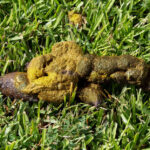 Yellow Dog Poop? Our Veterinarian Shares What to Do - Keeping an eye on your dog’s poop color and consistency can really help you spot changes in his health. One… [...]
Yellow Dog Poop? Our Veterinarian Shares What to Do - Keeping an eye on your dog’s poop color and consistency can really help you spot changes in his health. One… [...] Black Dog Poop? Our Veterinarian Shares What You Should Do - We’re all aware that the normal color of dog poop is brown. It may come in different shades, and some… [...]
Black Dog Poop? Our Veterinarian Shares What You Should Do - We’re all aware that the normal color of dog poop is brown. It may come in different shades, and some… [...] White Dog Poop: Why It Happens and What to Do - Veterinarians see a lot of different colored dog poop, but one color that might surprise dog owners is white. It… [...]
White Dog Poop: Why It Happens and What to Do - Veterinarians see a lot of different colored dog poop, but one color that might surprise dog owners is white. It… [...] Green Dog Poop: A Vet Shares When to Worry [with Pictures] - Before becoming a veterinarian, my life was not so focused on poop. Now that I’m in practice, I am constantly… [...]
Green Dog Poop: A Vet Shares When to Worry [with Pictures] - Before becoming a veterinarian, my life was not so focused on poop. Now that I’m in practice, I am constantly… [...] Dogs Not Pooping for 3 Days Need Veterinary Care - As a practicing veterinarian, I encounter dogs with constipation issues at least once a week. There are many different factors… [...]
Dogs Not Pooping for 3 Days Need Veterinary Care - As a practicing veterinarian, I encounter dogs with constipation issues at least once a week. There are many different factors… [...]Disclaimer: This website's content is not a substitute for veterinary care. Always consult with your veterinarian for healthcare decisions. Read More.



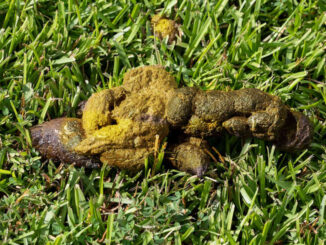


Thank you for this informative post! I was really worried when I noticed blood in my dog’s poop, but your explanation and suggestions for what to do next were incredibly helpful. It’s reassuring to have a vet’s perspective. I’ll definitely be keeping a close eye on my pup now!
Thank you for this informative post! I had no idea that blood in my dog’s poop could signify so many different issues. The detailed images and explanations were really helpful in understanding what to look for. I’ll be sure to keep an eye on my pup and reach out to my vet if I notice anything unusual.
Thank you for this informative post! It’s so distressing to discover blood in my dog’s poop, and I appreciate the clear steps you’ve outlined on what to do next. The pictures were really helpful too. I’ll definitely be keeping a close eye on my pup and following your advice.